Creators, Makers, and Doers: William Lewis
Posted on 9/30/15 by Arts & History

Painting is a serious pursuit for William Lewis and one that he feels is a lifetime commitment. When he is not working at his full-time job teaching high school art, William devotes as much time as he can to his practice. He focuses upon his own personal engagement with the paint and his subject matter. His work can be found at the Boise Art Museum, Ochi Gallery in Ketchum, and in various shows around the Treasure Valley and beyond.
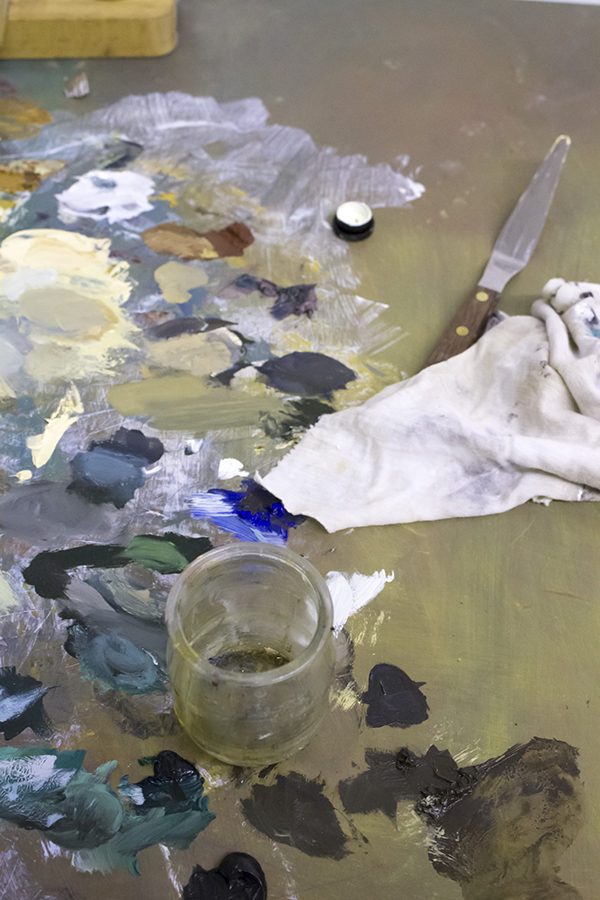
What is your preferred medium?
I’m a painter and work with oil paint primarily. It’s a pretty traditional material approach, usually on canvas or linen. I have been drawing more recently. Drawing was always just something within the process of painting – to help make decisions in the process of painting – but lately I have been drawing just for the sake of drawing. But mostly, I work with oil paint.

Why are you drawn to painting?
Paint is so malleable and can be used in so many different ways. It is so tactile that it is almost a direct expression of the body, as well as the mind, in a way. When I am engaged with paint it sometimes feels unmediated which, I know, is not the case, but it feels that way. There is a directness that I really like. There is also a mystery to it – how things come and go in the process.
I took a lot of painting courses during my education, but none of them really focused on the technical aspects of painting, which was fine with me. I wasn’t really interested in learning set and established traditional techniques. I have tried to keep that searching in my practice, though some of my paintings look traditional. That has really arisen out of working with the material and intuiting from paintings that I respond to from the past. It is really about learning and exploring the medium, not relying on set of established techniques. Inevitably there will be some reinvention of the wheel, but oh well. I really like that about painting. It is the kind of medium that one could explore for a lifetime and never really get to the end of the possibilities.
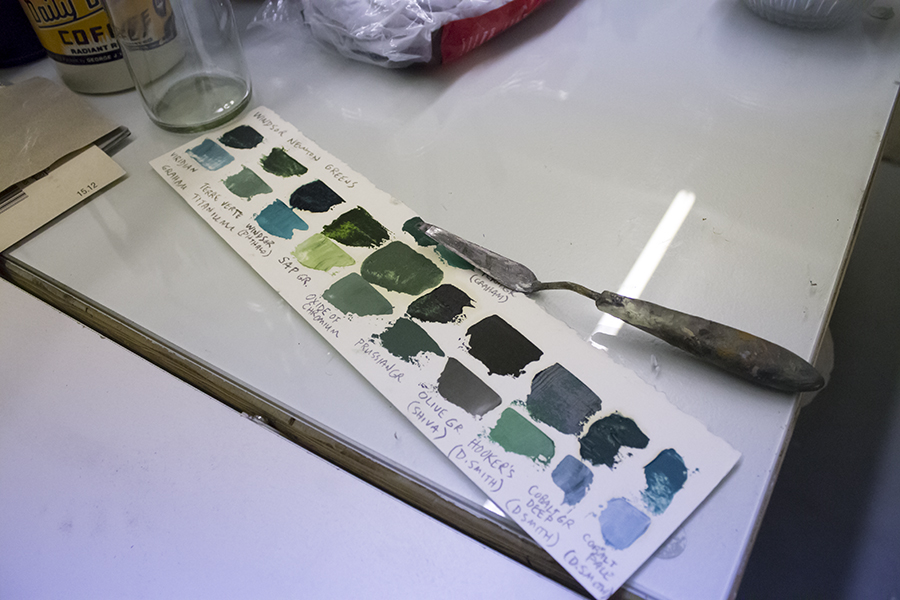
How long have you been painting?
Well I started painting kind of seriously in high school. It has been a long time, thirty years or something. I still feel like a beginner most of the time. It feels like starting from scratch, in a good way. You have to figure it out. You have to figure out what will work for this particular impulse or particular vision that you have or that you want to manifest.

What does your process look like?
Well, I don’t really have a typical or standard process. That is one of the things that I try to avoid, relying on a particular method, both in how I decide on the imagery to employ and the procedure that I use to paint. The paintings don’t even start the same way. I want to avoid becoming mechanical or relying too heavily on the same skills or techniques. That is no fun. If I try to do it, it is disastrous anyway. One has to be responsive to what is happening right now within a painting and all of the steps you’ve taken previously in that painting, including all of the mistakes and all of the inept things that inevitably happen. You have to take those into account and find a way to work with them. The ways you go about doing that can’t be something that is pre-established. They can’t be for me, anyway. I don’t know how other people work.
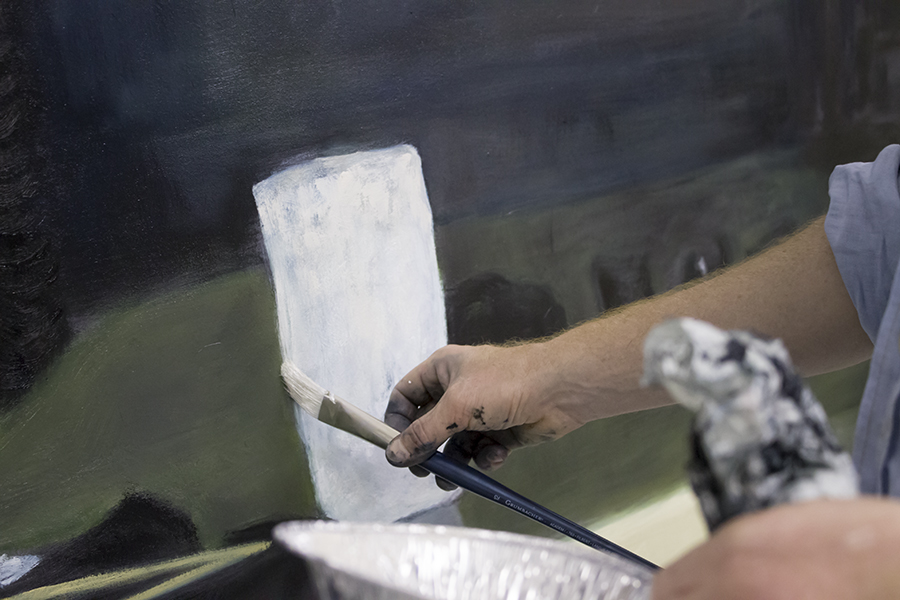
What are you working on now?
Lately, I have been grappling with my own memories and my family history as sources for imagery. This is new for me. In the last ten years or so I have worked in series where there’ll be an idea or theme that I want to explore. That can usually sustain my interest for a year or so until I have exhausted that particular vein. Then I try to evolve into something else, but this particular body of work feels like it could go on and on for a long time.
The imagery is derived from a home video that I made twenty-five years ago. I had forgotten about it. Upon watching it again about a year ago, I was overwhelmed with waves of feelings. I found this surprising and hard to account for as the content of the video is mostly pretty mundane footage of my Grandparents’ house. It was like one of those moments — like Marcel Proust and the madeleine. The famous episode at the beginning of In Search of Lost Time when he eats a cookie and it transports him to his youth in a way that is almost beyond language and completely unexpected. I had that sort of sensation watching the video. To explore that and see if I could imagine my way back into that time and those places and the sensations associated with them intrigued me. It sounds extremely personal and uninteresting to anyone else, but I hope I’m being thoughtful and particular about what images I choose and how they evolve within the paint. To draw people in, make them curious and trigger their own feelings of remembrance is the goal.
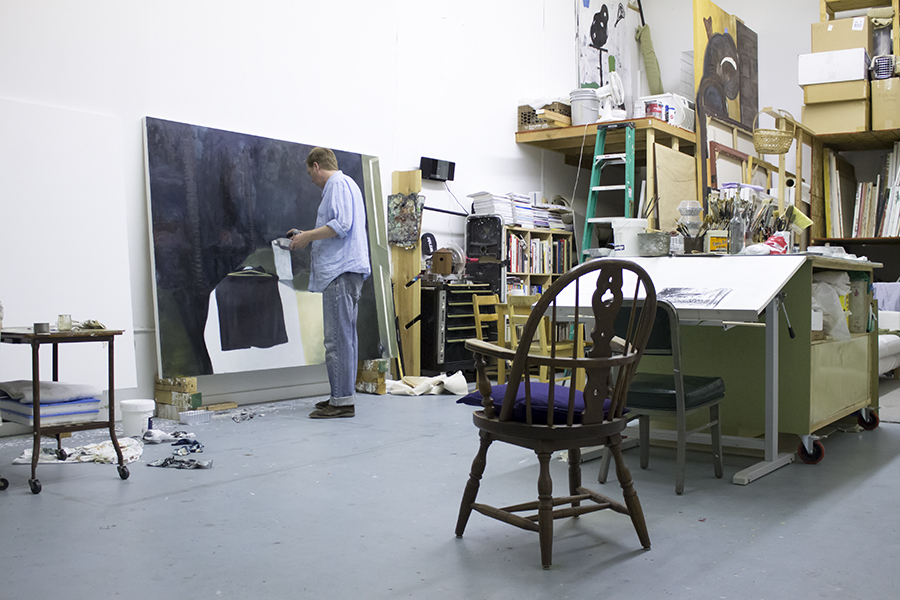
What does your creating schedule look like? What does your typical or ideal schedule look like?
I can’t say that I have ever had an ideal day in the studio. The typical day really depends on what time of year it is. I have a full time job as a teacher, so for nine months of the year my work day is interrupted. In the summer when I can work as I please, without interruption, the typical day is to arrive early, work a couple of hours in the morning, have some lunch, and come back in the afternoon. It varies though, of course. It depends what is underway in the studio and what needs attention.

Do you try to devote a certain time per day or per week to your practice?
Well, just as much time as I can manage. I have to be sort of selfish with time. As all people who work creatively know, you need a great deal of time, which to a lot of people may look like you are not doing a whole lot of anything. It is necessary to have time to think and look and just mess around and play. All of that takes a lot of time. I just try to spend as much time as possible.
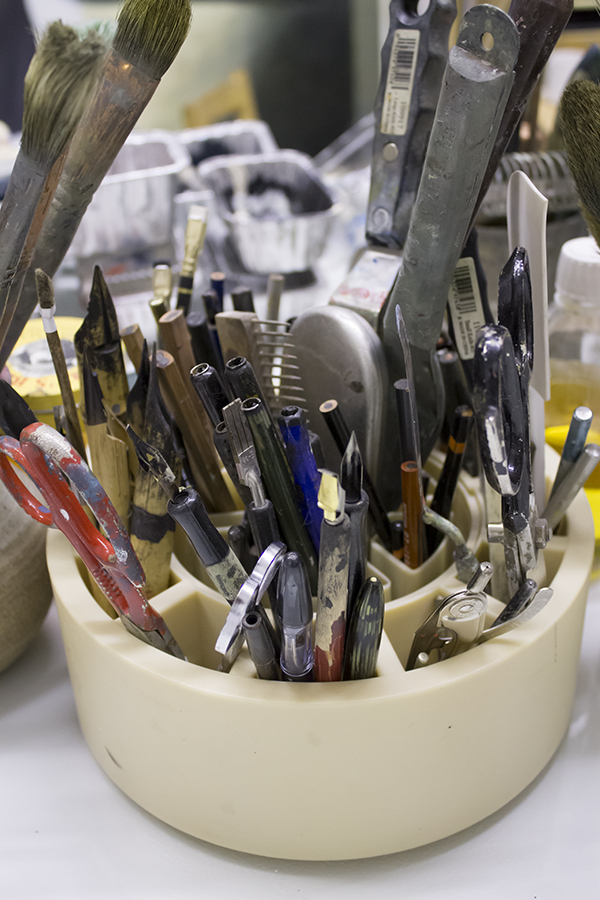
What drives you to keep working outside of having a full time job?
Ultimately, it is the really strong desire to say something real and occasionally having a glimpse that you are getting at that something real. The dynamic that I recognize in my own work over the years is that the best thing you have ever done is what you are working on right now. When you feel like you have gotten to a point with it where you have really learned something and said something and arrived at something, then that can be a really profound sense of accomplishment. Unfortunately, that tends to last only a short period of time until the feeling dissipates. You feel like you probably could have done it differently or better or you want to find something else to believe in. I guess that is what ultimately motivates me, the sense of trying to discover something. I think, like most human endeavors, the results are never ideally what you were trying to do and that motivates you to keep going and try again.
A friend of mine used this expression, he had been working a really long time as a painter, and he said something like he longed to “touch the flame of truth.” It is a super-romantic and poetic image, but I think there is something to it. We just have this desire to get closer and closer to something real, something that is not contingent. That is impossible, but it is what motivates me.

Where do you pull inspiration from? Where do you look for inspiration? Are you always inspired?
I don’t even know what that word means exactly. Where my imagery derives from has evolved over the years and changed dramatically. The work now has, superficially, almost nothing in common with what I was doing ten years ago or fifteen years ago. I see the connections, but on a superficial level they wouldn’t necessarily be apparent. I am motivated by experiences in my life, thinking about things in the past, as well as my interactions and experiences with art, both contemporary and from the past. You can’t discount how much art grows out of other art —responds to or attempts to modify, extend, or fight against. I am less and less engaged that way as I get older and more interested in my own experiences and trying to relate those to what I am doing or use those as a source. Of course, there are always paintings from the past that are tumbling around in my head.
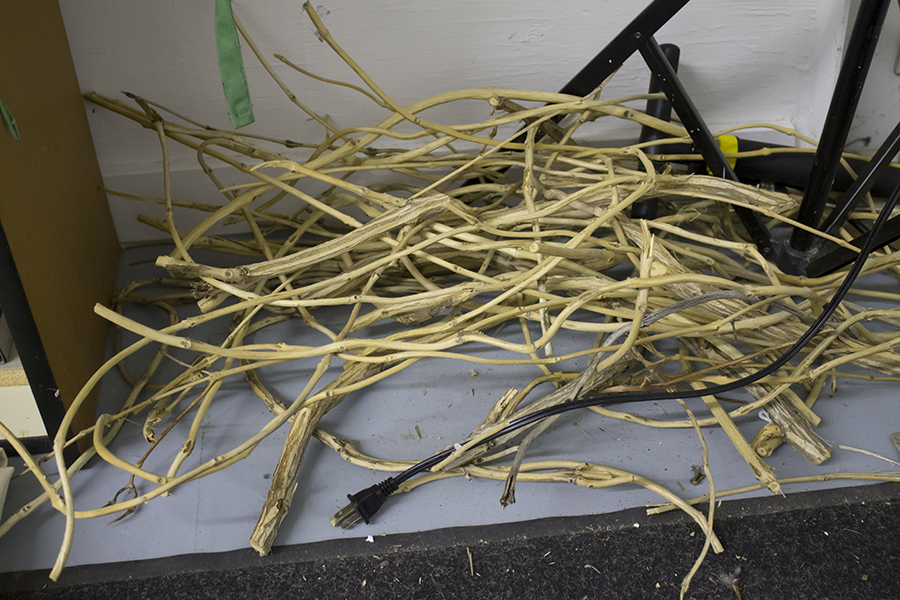
What is it that you are drawn to in other people’s artwork?
Directness is something that I look for and a lack of superfluous flourishes. A sense that it could not have been done any other way, that there is a sense of inevitability; somehow, even though it is surprising it feels inevitable. Those are some of the qualities that I respond to. Also a kind of awkwardness that some great works have, probably because the process of discovery that the person is engaged in may ultimately leave a kind of awkward quality. I certainly look for a lack of refinement or slickness that you may see from more academic artists.
Some of the great artists have a way of creating their own alternative world that has connections to our world, the everyday world, the world of people’s experiences, but it’s almost like a parallel world that is completely believable within its boundaries. I am not referring only to imagery that is “representational.” There are abstract artists that create their own worlds. You know when you are in that world. Philip Guston is a great example of a painter that created a parallel world.
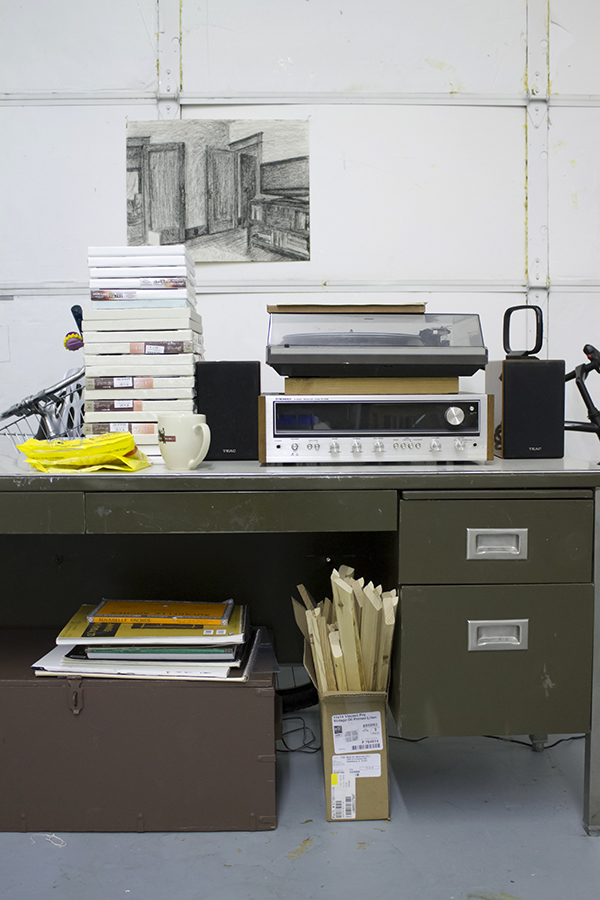
What keeps you working here in Boise?
I like Boise. In a lot of ways it’s a really good place to be a painter. It is perhaps not the best place to be a commercially oriented artist, but that’s not my primary concern. If one really wants to seek success in the commercial world, then it’s probably not the best place to base yourself. There are not that many opportunities here and we are pretty far from the more active art centers.
There are really good things about being here. The geographic location is hard to beat. The light, the high desert, the mountains are amazing.
On a practical level, because I have a full time job I can rent my studio and pay for my materials even if there is little income from the painting. The commercial concerns don’t enter into decision making at all. I can make what I want and I think that is a kind of freedom. Not that I am completely uninterested in promoting and exhibiting my work. Though it is more important to exhibit my work than sell it, but that’s a whole other conversation. Fortunately, there have been quite a few opportunities to exhibit work here. That has been gratifying.
It’s just a good place to live. I have been here a long time now and have no regrets about that.

Do you recognize any resources that are lacking for the arts community?
That sounds like a question for a managerial type. I think for this size city, the art community is pretty vibrant. I haven’t lived in a lot of towns as an adult that are comparable to Boise, so I can’t really compare. We have a decent regional museum, there are a couple of art spaces in town that have done and do interesting things, and there are the university galleries. If there is anything lacking, it would be in terms of commercial galleries, of which there are very few. I think that is something that can be attributed to the general public. It really takes a general public with an interest in and a knowledge of and curiosity about visual art for that to be possible. That’s something that could be improved. There are plenty of people engaged in that effort, but that is something that takes a long time to evolve. It has certainly changed and improved over time. It is arcing towards improvement in terms of general knowledge or general interest from the community, but it has a long way to go. It is so isolated here, like I said, and because of the setting there are a lot of people that are way more interested in other kinds of activities. So, growing that interested public is a challenge that everybody feels here. There are all kinds of interesting people seriously engaged in making and showing and educating. This kind of thing takes time.
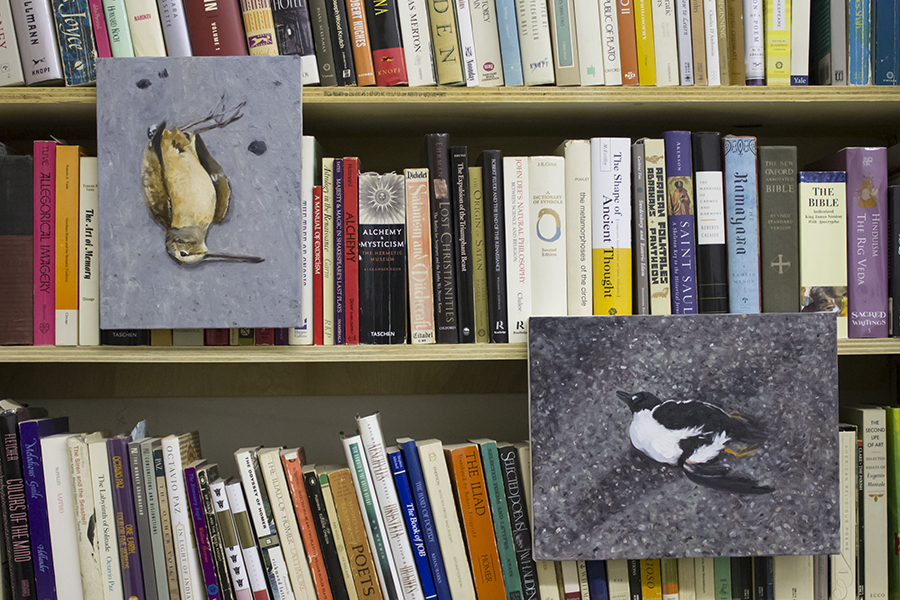
Where do you find the opportunities to both show and sell your work?
There is a lack of local commercial galleries that I think of as being serious. There are just a couple in town. I used to be represented by Jacque Crist before she closed her gallery. That was a really nice relationship. It is a little tricky. There are probably other people in town that would be able to speak to this better than I can. Talking about the commercial side of things is not as interesting to me, but in terms of exhibiting work, I think that is really an important aspect of making things. You are trying to communicate after all. You are trying to discover and then share that discovery with other people. Ideally you can alter their perceptions a little bit. I think that is kind of the goal. There are some local artists out there that support themselves with what they make. So, logically their interest lies in thinking about how not only to exhibit their work, but market it as well. I certainly respect that. It is not an easy thing to do, certainly not in a town the size of Boise. It is a funny contradiction in that having a full-time job is not ideal in terms of being consistently and completely within the studio, but at the same time it does allow a certain amount of freedom to not feel commercial pressures. It is a compromise I guess. Not to imply that people that are more engaged in the commercial side of things are compromising their vision. That is not necessarily the case, but it is something they must struggle with, unless they are willing to do whatever it takes to sell.

Would you say you have been able to make a living as an artist?
No, not at all. If you mean make a living like support myself financially? No. Not even close. That hasn’t been my focus or motivation. I wouldn’t want to be judged on those criteria. That is not the mark of whether one is successful or not. Everybody has a different definition of that. Ultimately my main concern is what happens here in my studio, what I am engaged in.
Creators, Makers, & Doers highlights the lives and work of Boise artists and creative individuals. Selected profiles focus on individuals whose work has been supported by the Boise City Dept. of Arts & History.
COMMENTS
Corey Koepnick says:
Mr. Lewis was easily the greatest teacher I had. I was lucky enough to have him in middle school, and in high school. I have taken what he taught me, and started my own business, designing and building firearms. My work can be seen on my instagram page, @aeroknox. My talents in design and machining has enabled me to work with the best of the best, including Jesse James as his lead designer and machinist. Thank you Mr. Lewis for all you do and have done.